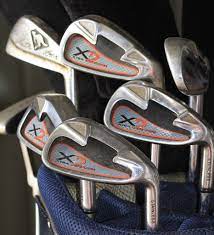
Understanding Iron Distances in Golf: A Comprehensive Guide
Golf is a game of precision, strategy, and technique. One of the most crucial elements determining a golfer's success is understanding their club distances, specifically their iron distances. Let's delve deep into this aspect of golf and explore everything you need to know.
Introduction
The game of golf revolves around several variables. While swing mechanics and golf grip are vital, the distance you can achieve with each club, particularly your irons, plays a crucial role in strategizing your game. Whether you're new to the sport or seeking to refine your technique, understanding iron distances can significantly enhance your gameplay.
The Basics of Iron Distances
Irons come in various lofts, each designed for specific shots and distances. Golf club lofts determine the trajectory and distance the ball can travel. A 3-iron, for instance, has a lower loft than a 9-iron. Consequently, the former can cover greater distances but with a lower trajectory compared to the latter.
Factors Influencing Iron Distances
Several elements come into play when determining the distance your irons can achieve:
- Swing Speed: The correlation between swing speed and distance is significant. A faster swing speed can result in the ball covering more ground.
- Equipment: The type of ball you use, its golf ball compression, and your club's clubhead design, can impact the distance. Modern irons, with specialized clubhead designs like cavity backs or perimeter weighting, can significantly alter ball travel.
- Physical Factors: The golfer's strength, age, and gender can influence the shot's power. Moreover, the golf stance and ball position play pivotal roles in optimizing the shot's potential.
- Environmental Factors: Course conditions like wind, altitude, and turf type can all add or subtract from the ball's travel distance.
Understanding Iron Distance Charts
An iron distance chart provides an average distance range for each iron, offering a baseline for golfers. However, individual variations are influenced by factors like swing speed, golf ball compression, and launch angle.
Improving and Maximizing Iron Distances
- Golf Swing Mechanics: Refining your technique can lead to greater distances. From improving your golf grip to adjusting your ball position, small tweaks can yield significant results.
- Equipment Choices: Modern golf technology has paved the way for equipment that maximizes iron distances. Using golf training aids can also help in refining your technique. Club fitting is another essential element, ensuring your irons are tailored to your unique swing.
- Practicing with Purpose: Regular practice, using tools like swing analyzers and understanding your spin rate, can enhance your game. Club selection becomes easier when you understand your strength with each iron.
Iron Distances for Specific Groups
Men, women, juniors, and seniors may have varying iron distances due to differences in strength, swing speed, and technique. A senior might prefer hybrid clubs over long irons for better distance coverage. Women might have different distance gapping due to equipment design tailored to their needs.
Iron Gapping and Strategy
Understanding the iron loft progression and consequent distances between each iron can aid in better club selection. This knowledge ensures you pick the right club for specific shots, making the most of your equipment.
Common Challenges and Solutions
Many golfers face challenges like declining distances. This drop could be attributed to various factors, from aging to a subtle shift in golf swing mechanics. It's essential to recognize these issues and employ solutions like tweaking the golf stance, using different golf ball compressions, or switching to clubs with specific shaft flex that align with your swing.
Tech and Tools
Embracing golf technology can revolutionize your understanding of iron distances. From apps that act as a golf club distance calculator to devices that analyze spin rate and launch angle, the modern golfer has an arsenal of tools at their disposal.
Conclusion
Mastering iron distances is more than just power; it's about precision, understanding equipment, and leveraging modern golf technology. By gaining insights into your game's intricacies and regularly refining your technique, you can ensure that your irons become an asset on the course.
FAQs on Iron Distances
Q1: How do I measure my iron distances accurately?
Answer: There are several methods to measure iron distances. One of the most accurate is using a golf rangefinder or a GPS device on the course. Additionally, golf simulators and launch monitors can provide detailed data, including spin rate, launch angle, and actual distance.
Q2: How does swing speed relate to distance?
Answer: Swing speed directly influences ball speed. Generally, the faster you swing, the further the ball travels. However, it's essential to have a balanced swing. Extremely high swing speeds without control can lead to inaccurate shots.
Q3: Why am I suddenly hitting my irons shorter?
Answer: A decrease in distance can result from several factors: changes in swing mechanics, equipment wear, physical issues like injuries, or even external factors such as playing at a different altitude or in colder weather. It's crucial to analyze your technique and consult with a coach or expert to pinpoint the issue.
Q4: What is the role of golf ball compression in iron distances?
Answer: Golf ball compression refers to the ball's ability to compress upon impact. Lower compression balls tend to be softer and can benefit players with slower swing speeds, offering more distance. Conversely, high compression balls are suited for players with faster swing speeds, ensuring optimal energy transfer for maximum distance.
Q5: How does the loft of an iron influence its distance?
Answer: The loft of an iron affects the ball's trajectory. Lower lofts (like on a 3-iron) produce shots with a flatter trajectory but cover more distance. In contrast, higher lofts (like on a 9-iron) result in steeper trajectories with shorter travel distances but more control.
Q6: Are hybrid clubs a good alternative to long irons for better distance?
Answer: Yes, hybrid clubs combine the features of woods and irons. They offer the distance of woods while providing the control and playability of irons. For many golfers, especially seniors and those with slower swing speeds, hybrids can be easier to hit and provide consistent distances compared to long irons.
Q7: How often should I get a club fitting to ensure optimal distances?
Answer: Ideally, players should consider club fitting every couple of years or if there's a significant change in their gameplay, such as alterations in swing speed or mechanics. Regular check-ins with a professional can ensure your equipment complements your game.
Q8: Can the shaft flex of my irons influence distance?
Answer: Absolutely. The shaft flex impacts the club's performance, affecting both distance and accuracy. For instance, a more flexible shaft (like a regular or senior flex) can benefit players with slower swing speeds, while stiffer shafts can optimize performance for those with faster swings.
